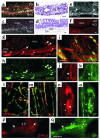Alimentary tract innervation deficits and dysfunction in mice lacking GDNF family receptor alpha2
- PMID: 12952919
- PMCID: PMC182204
- DOI: 10.1172/JCI17995
Alimentary tract innervation deficits and dysfunction in mice lacking GDNF family receptor alpha2
Abstract
Subsets of parasympathetic and enteric neurons require neurturin signaling via glial cell line-derived neurotrophic factor family receptor alpha2 (GFRalpha2) for development and target innervation. Why GFRalpha2-deficient (Gfra2-/-) mice grow poorly has remained unclear. Here, we analyzed several factors that could contribute to the growth retardation. Neurturin mRNA was localized in the gut circular muscle. GFRalpha2 protein was expressed in most substance P-containing myenteric neurons, in most intrapancreatic neurons, and in surrounding glial cells. In the Gfra2-/- mice, density of substance P-containing myenteric ganglion cells and nerve bundles in the myenteric ganglion cell layer was significantly reduced, and transit of test material through small intestine was 25% slower compared to wild-type mice. Importantly, the knockout mice had approximately 80% fewer intrapancreatic neurons, severely impaired cholinergic innervation of the exocrine but not the endocrine pancreas, and increased fecal fat content. Vagally mediated stimulation of pancreatic secretion by 2-deoxy-glucose in vivo was virtually abolished. Retarded growth of the Gfra2-/- mice was accompanied by reduced fat mass and elevated basal metabolic rate. Moreover, the knockout mice drank more water than wild-type controls, and wet-mash feeding resulted in partial growth rescue. Taken together, the results suggest that the growth retardation in mice lacking GFRalpha2 is largely due to impaired salivary and pancreatic secretion and intestinal dysmotility.
Figures







Similar articles
-
Neurturin signalling via GFRalpha2 is essential for innervation of glandular but not muscle targets of sacral parasympathetic ganglion neurons.Mol Cell Neurosci. 2004 Feb;25(2):288-300. doi: 10.1016/j.mcn.2003.10.019. Mol Cell Neurosci. 2004. PMID: 15019945
-
Sympathetic cholinergic target innervation requires GDNF family receptor GFR alpha 2.Mol Cell Neurosci. 2004 Jul;26(3):450-7. doi: 10.1016/j.mcn.2004.04.003. Mol Cell Neurosci. 2004. PMID: 15234349
-
Parasympathetic innervation and function of endocrine pancreas requires the glial cell line-derived factor family receptor alpha2 (GFRalpha2).Diabetes. 2005 May;54(5):1324-30. doi: 10.2337/diabetes.54.5.1324. Diabetes. 2005. PMID: 15855316
-
[Neurturin: a relative of glial-cell-line-derived neurotrophic factor].Sheng Li Ke Xue Jin Zhan. 1998 Apr;29(2):151-4. Sheng Li Ke Xue Jin Zhan. 1998. PMID: 12501685 Review. Chinese. No abstract available.
-
Relation between gut motility and innervation in man.Digestion. 1974;11(5-6):392-6. doi: 10.1159/000197607. Digestion. 1974. PMID: 4618538 Review. No abstract available.
Cited by
-
scRNA-Seq Reveals New Enteric Nervous System Roles for GDNF, NRTN, and TBX3.Cell Mol Gastroenterol Hepatol. 2021;11(5):1548-1592.e1. doi: 10.1016/j.jcmgh.2020.12.014. Epub 2021 Jan 11. Cell Mol Gastroenterol Hepatol. 2021. PMID: 33444816 Free PMC article.
-
Development of enteric neuron diversity.J Cell Mol Med. 2009 Jul;13(7):1193-210. doi: 10.1111/j.1582-4934.2009.00813.x. Epub 2009 Jun 16. J Cell Mol Med. 2009. PMID: 19538470 Free PMC article. Review.
-
Enteric nervous system development: what could possibly go wrong?Nat Rev Neurosci. 2018 Sep;19(9):552-565. doi: 10.1038/s41583-018-0041-0. Nat Rev Neurosci. 2018. PMID: 30046054 Free PMC article. Review.
-
Dual cholinergic signals regulate daily migration of hematopoietic stem cells and leukocytes.Blood. 2019 Jan 17;133(3):224-236. doi: 10.1182/blood-2018-08-867648. Epub 2018 Oct 25. Blood. 2019. PMID: 30361261 Free PMC article.
-
The developmental etiology and pathogenesis of Hirschsprung disease.Transl Res. 2013 Jul;162(1):1-15. doi: 10.1016/j.trsl.2013.03.001. Epub 2013 Mar 22. Transl Res. 2013. PMID: 23528997 Free PMC article. Review.
References
-
- Manié S, Santoro M, Fusco A, Billaud M. The RET receptor: function in development and dysfunction in congenital malformation. Trends Genet. 2001;17:580–589. - PubMed
-
- Takahashi M. The GDNF/RET signaling pathway and human diseases. Cytokine Growth Factor Rev. 2001;12:361–373. - PubMed
-
- Airaksinen MS, Saarma M. The GDNF family: signalling, biological functions and therapeutic value. Nat. Rev. Neurosci. 2002;3:383–394. - PubMed
-
- Baloh RH, Enomoto H, Johnson EMJ, Milbrandt J. The GDNF family ligands and receptors — implications for neural development. Curr. Opin. Neurobiol. 2000;10:103–110. - PubMed
-
- Rossi J, Tomac A, Saarma M, Airaksinen MS. Distinct roles for GFRα1 and GFRα2 signalling in different cranial parasympathetic ganglia in vivo. Eur. J. Neurosci. 2000;12:3944–3952. - PubMed
Publication types
MeSH terms
Substances
LinkOut - more resources
Full Text Sources
Medical
Molecular Biology Databases

